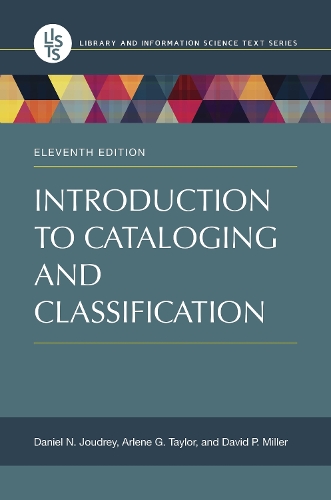
Introduction to Cataloging and Classification
(Hardback, 11th edition)
Available Formats
Paperback, 11th edition
Published: 29th September 2015
Hardback, 11th edition
Published: 29th September 2015
Publishing Details
Introduction to Cataloging and Classification
By (Author) Daniel N. Joudrey
By (author) Arlene G. Taylor
By (author) David P. Miller
Bloomsbury Publishing PLC
Libraries Unlimited Inc
29th September 2015
11th edition
United States
Classifications
Professional and Scholarly
Non Fiction
025.3
Physical Properties
Hardback
1080
Width 178mm, Height 254mm
2041g
Description
A new edition of this best-selling textbook reintroduces the topic of library cataloging from a fresh, modern perspective. Not many books merit an eleventh edition, but this popular text does. Newly updated, Introduction to Cataloging and Classification provides an introduction to descriptive cataloging based on contemporary standards, explaining the basic tenets to readers without previous experience, as well as to those who merely want a better understanding of the process as it exists today. The text opens with the foundations of cataloging, then moves to specific details and subject matter such as Functional Requirements for Bibliographic Records (FRBR), Functional Requirements for Authority Data (FRAD), the International Cataloging Principles (ICP), and RDA. Unlike other texts, the book doesn't presume a close familiarity with the MARC bibliographic or authorities formats; ALA's Anglo-American Cataloging Rules, 2nd Edition, revised (AACR2R); or the International Standard Bibliographic Description (ISBD). Subject access to library materials is covered in sufficient depth to make the reader comfortable with the principles and practices of subject cataloging and classification. In addition, the book introduces MARC, BIBFRAME, and other approaches used to communicate and display bibliographic data. Discussions of formatting, presentation, and administrative issues complete the book; questions useful for review and study appear at the end of each chapter.
Reviews
All in all, the authors have done a fine job with this eleventh edition, a job which its original author, Margaret Mann, undoubtedly would admire and find extremely helpful for students and other pre-professionals that need to learn about catalogingwhat it is, what it should accomplish, and how it is done. Buyers will get a lot for their money. * Technicalities *
I recommend this book to instructors and students, to practicing professionals and paraprofessionals, and to selectors for libraries that support library science curricula. Ideally, this text would be used in conjunction with a wide variety of practical exercises in original cataloging and the creation of authority records. * Technical Services Quarterly *
This lucidly written book assumes no prior knowledge on the part of readers, and thus can be equally used by the novice and the expert. * Library Progress International *
Author Bio
Daniel N. Joudrey, MLIS, PhD, is professor in the School of Library and Information Science, Simmons College, Boston, MA, where he teaches information organization, subject cataloging and classification, and descriptive cataloging. Arlene G. Taylor, MSLS, PhD, is professor emerita, School of Information Sciences, University of Pittsburgh, and distinguished adjunct professor, School of Information and Library Science, University of North Carolina, Chapel Hill. David P. Miller, MA, MSLIS, is professor and head of technical services at the Levin Library, Curry College, Milton, MA.
